

Air conditioning and refrigeration equipment requires less energy to power the turbines and the compressors with cold water2. The colder the water in chemical plant processes, the more efficient the condensation process and the greater the volume of saleable product yielded at lower cost. The hot water in power generation stations produces an energy penalty which deprives the facility of power sales. Poor vacuums and higher back pressures on turbines, due to insufficient cooling water, require additional energy to produce design kilowatts, which reduces profits.
After the cooling tower has been erected, proper operation and maintenance is required to yield full unit production. With poor maintenance, the towers can lose appreciable performance. To emphasize the amount of actual dollar loss by a malfunctioning cooling tower, the calculations are enumerated further on. A deficient (low-bid nominal) cooling tower plus improper maintenance can mean tower performance loss, which could amount to as much as 5°F added to cold water temperature. What does 5° in cold water temperature from a cooling tower mean to an operating unit?
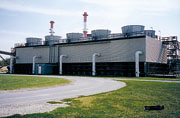
The Air Conditioning System
Let’s look at a 590-ton absorption-type machine. We assume a 5° rise in cold water temperature due to poor operation, maintenance, and/or the purchase of the “low-bid nominal cooling tower” syndrome without understanding the performance parameters of the design conditions. Consider a Gulf Coast air conditioning system with a design hot water temperature (HWT) of 95° at design wetbulb temperature (WBT) of 80°, and an 85° cold water temperature (CWT) in actual operation on a 2,120 gpm cooling tower. Assume operation at 44° chilled water temperature, and 12 psig steam pressure.The manufacturer’s data for this absorption machine indicates a loss in capacity of 72 tons (12.2%) due to the high condenser water temperature. The incremental cost of equipment to increase tonnage back to design is approximately $500/ton for this type of operation. Thus the total cost differential is:
$500 x 72 = $36,000 per year
This loss could have been eliminated if about 10% more was put into purchasing a cooling tower adequate for the job.
Enthalpy charts indicate that for every 1° of colder water going to the compressor, there is a 2.25% reduction of electric energy required to power the equipment3. Therefore, a 5° cold water reduction would be a 10% savings that could amount to almost $40,000 per year for a 1,000 ton system in the Houston area and an energy cost of $0.08 per kWh. Figure 1 provides incremental savings possibilities.
Multiply even a half-degree warmer water on the absorber for a ten-year period, and the significance of a poorly performing cooling tower is evident. A five-degree deficient cooling tower loss is incredibly expensive, and since a building’s electric bill is for all systems, management typically does not have a breakdown of costs to determine what the electric light bulbs cost, let alone the overcharge for excessive energy required to overcome a deficient cooling tower in the air conditioning system.
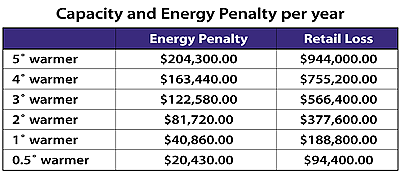
Chemical Plant Process Water
The next example involves a chemical plant, located in the Texas Gulf Coast, where the cooling tower was originally designed to cool 8,000 gpm of water entering the tower at 111° HWT and leaving at 90° CWT, at a 75° WBT. It illustrates how changing the wet decking heat transfer surfaces alone produced startling production results.The water was not being returned cold enough to do the work properly, and the production planning unit budgeted $75,000 to install another cooling tower to make up the deficiency plus provide the capability for a 30% plant expansion contemplated in the future. Thermal calculations4 indicated that with the present water distribution system, 24 in. of cellular fill would more than adequately return the 8,000 gpm back to the process equipment at 90° CWT. After conversion, this actually occurred.
Further calculations show that the addition of another 24 in. for a total of 48 in. deep pack of cellular fill, together with a new water distribution system consisting of PVC piping and ceramic square spray nozzles, would be sufficient to expand the water cooling capability of the tower by 30%4.
Since the cost of this conversion is $19,500, we can calculate an actual annual savings of $20,500 plus at least $16,300 from not having to operate an additional 25-hp motor for the now nonexistent “new” tower. To calculate the effect on the company’s bottom line due to inadequate cooling water, if the plant is typical and operates 300 days per year on a 24-hr basis, a one-half degree hotter temperature will result in a $5,356,000 loss of saleable product. The extreme case of a five-degree deficiency could cost the petrochemical plant $53,280,000 in product sales.
If this seems exaggerated, divide the loss by 50%, and it still is a serious dollar loss that can be corrected if a larger, more efficient cooling tower is employed.
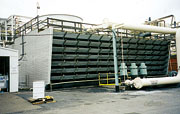
Next: A 600-Megawatt Power Plant
Let us consider a 600-MW steam turbine power plant, operating at 440 MW with a heat rate of 7,946 Btu/kW. An increase in condensing pressure from 3.0 in. to 3.5 in. HG absolute (115.06°) will increase the heat rate by 0.7%. That is, the added heat rate is .0067 x 7,946 = 53 Btu/kW. Assume fuel cost is $1.00/million Btu.For 400-MW production, the added cost of the 5.5° increase in condenser water temperature is:
53 x 440 x 10 ft x $1.00 = $23.32/hr = $204,300/yr
Alternatively, instead of increased fuel cost, consider lost production for the 5.5°increase in condenser temperature.
Capacity reduction = 0.68%
kW/h loss = 440 x 1,000 x 0.068 = 2,992 kWh
Representing the sale price of electricity (for home use) at $0.036/ kWh, one can calculate the following.
Loss/day = 2,992 x 0.036 x 24 = $2,585/day = $930,600/year
The aforementioned example then shows a $204,300 per year increase in fuel costs to maintain production due to the 5° performance shortage in the cooling tower, or a loss in retail sales of electricity at $930,600 a year to maintain the same heat rate.
Consider that both of these examples illustrate a 5° loss in performance. While this reduction of efficiency is quite high, it is not uncommon. However, Figure 2, on a straight line proportion, indicates the loss for less than a 5° deficiency.
The Tennessee Valley Authority and the Electric Power Research Institute (EPRI) made a survey of wet cooling towers in the power generating industry, and they found that 65% of the cooling towers surveyed were performing at only 80% of capability, or 20% short. They stated this deficiency was costing the American electric generating industry over $100 million per year in added power or loss of sales5.

Monophosphate Plant Counterflow
In investigating this plant’s problem from a rebuilding engineering point of view, it was determined that the situation would improve significantly if the large, inefficient, triangular, old-fashioned wooden splash bars were replaced with state-of-the-art cellular film fill.A consultant performed the thermal test, before and after rebuilding. In addition to the percentage of capability, the consultant could provide a report outlining the reasons the tower is deficient, together with specifications and a budget, which will correct the shortage.
Inefficient wooden splash bars were replaced with 42 in. of cellular fill. If the three 50-hp motors were rewound for 60-hp duty, they would generate sufficient air to cool 4,160 gpm of water each per cell, which could then be cooled to the design requirements of water entering the tower at 102°, cooling to 85° at an ambient temperature of 77° wb.
Another of the keys to making this upgrade work was the replacement of the old-fashioned gravity water trough distribution to a PVC piping system and the installation of large-area-coverage square spray via 1.25-in. orifice ceramic nozzles. As an extra margin, new cellular drift eliminators were also installed, generating less static pressure than the heavy cross-section wood drift eliminator blades.
The monophosphate plant production engineers developed a curve, seen in Figure 3, showing the relationship between production and cold cooling tower process water.
It can be seen that a decrease of 3° from the old 78° to 75° results in an extra 12 tons per hour of production. The cooling tower rebuilding cost of $750,000 was more than paid back, since this increased production was worth about $1 million in extra sales of product per year.
When installing cellular fill, an important consideration is that there must be a very uniform coverage of water from an efficient nozzle system and a comprehensive, professional, chemical water treatment regime.
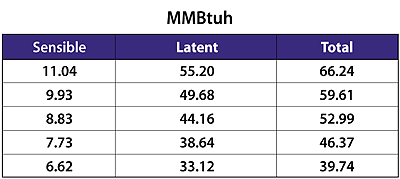
Overhead Catalytic Cracker
components over the temperature range of 140° to 80°. For simplicity’s sake, assume straight line condensation and the following factors. The heat of vaporization = 120 Btu/lb. The specific heat of the vapor is 0.4 Btu/lb/°F. Total inlet flow is 460,000 lbs/hr of hydrocarbon.Then:
Q = (460,000)(.40 x 60˚) + (120°)
= 66.24 MMBtuh And assume:
U = 200 Area = 13,500 ft2
Figure 4 then begins to illustrate the results of the example, which would eventually indicate an 8.4% differential in product recovery from the overhead condenser, and a dollar cost which could easily pay for purchasing a larger, more efficient cooling tower involved in less than two weeks.
Figure 5 calculates the loss of product due to deficient cooling water provided to the process equipment.
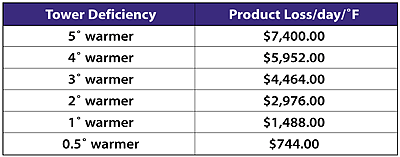
Conclusion
A blanket statement cannot be made that all cooling towers can be rebuilt to save quantities of money and power, or can return water significantly cooled. Each installation must be treated on an individual basis, with thermal, hydraulic, and aerodynamic calculations of existing conditions studied by a competent cooling tower consultant or cooling tower engineer to see where areas of improvement can be anticipated. Since considerable sums of money can be disbursed on large-size cooling towers, it is strongly recommended that a testing requirement be made part of the contract.Thermal testing can be conducted in-house for a close estimate. However, any good operator can tell by production results or the quality of air conditioning whether or not the cooling tower’s cold water is adequate or not. For a precise evaluation, it is recommended that a test, in accordance with the Cooling Tower Institute (CTI) Acceptance Test Code ATC-105, be made by a qualified professional cooling tower engineer with approved instrumentation.
A certified CTI test will only provide the percent of capability the tower is operating under, compared to the 100% it was purchased for6. Rebuilding and retrofits should be seriously considered over installing new equipment with the added cost of a new concrete basin, piping, and wiring.
The CTI has formulated ATC 105, which contains rigid testing procedures for determining whether or not a cooling tower will produce what the customer has been promised. The CTI will contract to have testing performed for the customer at a fee. A qualified cooling tower rebuilding firm could conduct a test under strict supervision of the owner’s representative6. Or, a qualified consultant can test the tower and also delineate areas of weakness and upgrading potential, with specifications and budget.
The dollar expense of retrofitting and rebuilding to upgrade the capacity in obtaining colder water or the capability of putting additional gallon capacity of the existing system, without capital expenditure for a new oem tower, has a rapid payback if the proper investigative engineering is performed and the work is done competently.
With proper maintenance and application of sound modern engineering principles, a cooling tower can be given a new lease on life and produce colder water, which will in turn assist in putting money in the bank for the owner. ES
